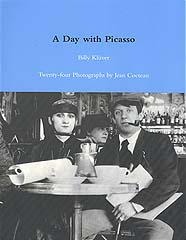by Robert Fulford
(Globe and Mail, March 27, 1999)

|
The sleuth of Montparnasse by Robert Fulford (Globe and Mail, March 27, 1999) |

|
The result of his labour, A Day with Picasso: 24 Photographs by Jean Cocteau (MIT Press, 99 pages, $23.95, paperback), is astonishing in its painstakingly assembled detail. It demonstrates archival research at its most exotic, a case of scholarship for scholarship's sake. Even so, I haven't opened a more charming or fascinating book in months.
Klüver is a one-time teacher of electrical engineering at the University of California who became known in the American avant-garde of the 1960s. With Robert Rauschenberg and others, he organized a project he called Experiments in Art and Technology (EAT) to help scientists and artists collaborate on public art projects.
He began work on these Picasso photos in 1978, by accident. While he was picking his way through vast collections of amateur pictures for a book about artists in Montparnasse early in the century, he came on five unlabelled photos that were obviously shot at the same time, since they showed the same people in the same clothes. One of the people was Pablo Picasso. Another was Amedeo Modigliani. A third was a glamorous 20-year-old model, Emilienne Pâquerette Geslot, professionally known only by her middle name. Pâquerette was then Picasso's girlfriend (though she ended up as the wife of a cardiologist). She made this occasion visually memorable by showing up in an outlandish hat that, today, looks like the rig worn a few years ago during experiments with virtual reality; in 1916, it was someone's idea of a daring fashion statement.
Klüver had no idea when these pictures were taken, or who took them. He approached them like an archeologist who assembles fragments of broken earthenware, hoping they will eventually turn into a vase or a pitcher. He found five more photographs and, as he studied the shadows falling on a building in one of them, it occurred to him that they might tell him the date and time.
After he discovered that some of the photos were taken at the Café de la Rotonde, he was able (with the help of the Bureau des longitudes), to calculate the date, within about 30 days. To find the year, he studied diaries and biographies, noting when Picasso, Modigliani and the others were in Paris. He concluded that it had to be 1916. He learned the photographer's identity when he noticed, in a book of Jean Cocteau's art, that several drawings were loosely based on these photographs. In the Cocteau Archive at the Musée de Luneville, he found six more photographs and some of the negatives. He turned up a letter from Cocteau that established the date.
Klüver came across other photos in 1920s magazines and in the catalogue of a Modigliani show. By 1986, having accumulated 18 of the series, he published them as an article for Art in America. That drew three more out of the woodwork. He made the 21 he now possessed into a book, issued in German in 1993 and French in 1994. Finally, he acquired a 22nd. The current book contains two other pictures, in which the composer Erik Satie appears; Klüver believes Cocteau took them a few days before Aug. 12, on the first of the rolls he would use with Picasso. Cocteau seems to have exposed four rolls with six shots each, so all are now present and accounted for.
But how to put them in order? A computer printout of sun positions, as they would have appeared that day at the observatory in Montparnasse, gave him his method. "To calculate the time of day, I used the angle of the shadow that the sun's rays make on a vertical plane from a vertical or horizontal obstruction." He determined where Cocteau had been standing as he took the pictures, and his book includes maps of that Montparnasse intersection, with each position noted.
Now that all the pictures are in order, Klüver can say for certain that Picasso and his friends met for coffee at La Rotonde, went across the street to Chez Baty for lunch, returned to La Rotonde, and at various points happily made fools of themselves for the camera. The Picasso photographed by Cocteau is not the intense, often scowling genius with whom we're familiar: This fellow in his checkered cloth cap is relaxed and happy.
That may have been because his great painting, Les Demoiselles d'Avignon, had recently created a stir when shown to the public for the first time. Or it may have been a response to a beautiful August day. Or Pâquerette.
A Day with Picasso will make some readers into amateur scholar-detectives, if only for a moment. The text under Photograph No. 4, which shows Picasso and three others chatting outside La Rotonde, tells us that the apartment in the background was then occupied by the family of Simone de Beauvoir, who was eight years old at the time. As I stared at the windows, it seemed to me that a face looked out of one of them -- though Klüver's cutline doesn't mention it. Could it be? I went for a magnifying glass and looked closer. Yes, for sure, a face. Or . . . is it a flowerpot, sitting in the window? I'd prefer it to be a face, Simone's face. But to be seen from the street, she would have had to be kneeling behind the window, and the angle of the shadow above her indicates . . .
